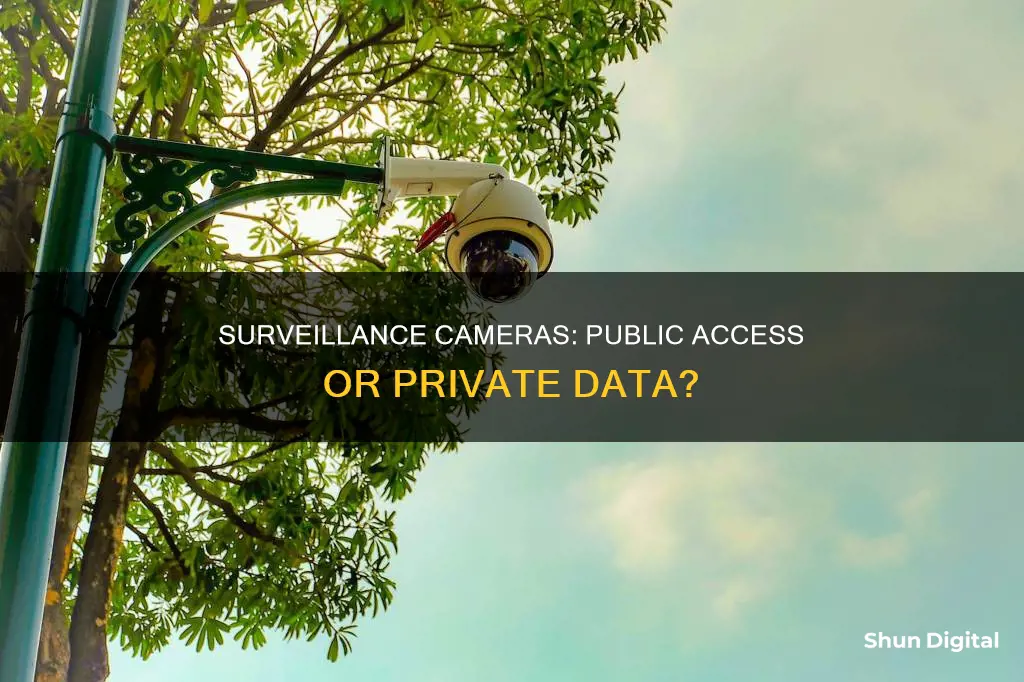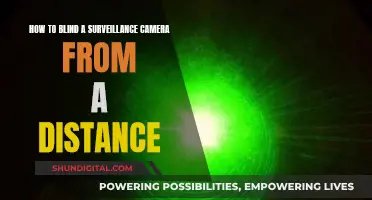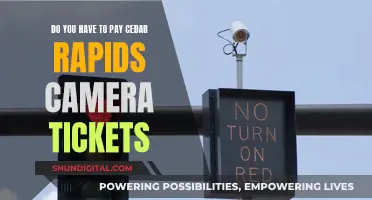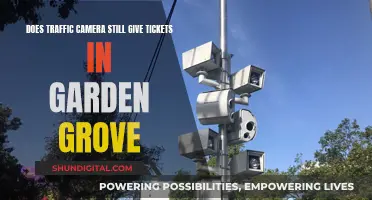
The use of surveillance cameras in public spaces has sparked debates about balancing their crime-fighting benefits with individuals' right to privacy. Surveillance cameras are widely available to the public, and their use has become prevalent in various settings, including homes, businesses, and public spaces. While some argue that surveillance cameras are effective at deterring and solving crime, others raise concerns about potential privacy invasions and the abuse of surveillance footage. The legality of installing and using surveillance cameras varies across regions and countries, with some jurisdictions implementing specific regulations to address these concerns.
| Characteristics | Values |
|---|---|
| Legality | In the US, it is usually legal to install a residential security camera and record video. However, there are no specific federal laws governing the use of security cameras, and local regulations vary. |
| Privacy | US citizens are guaranteed a reasonable expectation of privacy, which extends to video recording. This means that private places, such as bathrooms, cannot be recorded without violating privacy laws. |
| Consent | On a national level, it is legal to record a conversation if at least one person consents ("one-party consent" law). However, this does not cover video surveillance. |
| Law enforcement access | Law enforcement officers do not have the right to demand video footage from private residences. However, they may obtain footage that has been posted online or shared through apps. |
| Public access | Policies regarding public access to surveillance footage vary across different jurisdictions. In some cases, footage may be withheld to protect privacy or for law enforcement purposes, while other jurisdictions may require the release of footage as a public record. |
What You'll Learn

Public surveillance cameras improve public safety
Public surveillance cameras are a double-edged sword, offering benefits to public safety and security, but also raising concerns about privacy and civil liberties.
Improving Public Safety
Public surveillance cameras can improve safety in several ways. Firstly, they act as a deterrent to crime. The presence of cameras can make individuals less likely to commit crimes for fear of being caught. This preventive aspect of surveillance cameras helps in reducing the overall crime rate. Secondly, in the unfortunate event of a crime, surveillance cameras aid in catching the perpetrators. Facial recognition technology, combined with surveillance footage, enables law enforcement to identify and apprehend criminals more efficiently. This was evident in the Boston Marathon bombing case, where surveillance footage played a crucial role in identifying and apprehending the suspects within three days. Thirdly, surveillance cameras provide valuable evidence for investigations. Footage from these cameras can be used in legal proceedings, helping to convict guilty individuals and exonerate the innocent.
Surveillance cameras also provide a sense of security to the public. People feel safer knowing that cameras are monitoring public spaces, reducing their fear of crime. This sense of security can positively impact individuals' daily lives, allowing them to go about their activities with greater peace of mind.
Privacy and Civil Liberties Concerns
While public surveillance cameras offer safety benefits, they simultaneously raise concerns about privacy and civil liberties. The presence of cameras in public spaces creates a record of individuals' movements and activities, potentially infringing on their right to privacy. The data collected by these cameras can be vulnerable to misuse, unauthorised access, and hacking, posing risks to individuals' personal information and privacy.
Additionally, there is a lack of standardised regulations governing the use of public surveillance cameras. While certain jurisdictions have implemented or considered regulations, many areas have sparse laws or none at all. This lack of regulatory oversight increases the potential for abuse and misuse of surveillance footage, as evidenced by reports of surveillance cameras being used to record protestors and for voyeuristic purposes.
Balancing Safety and Privacy
In conclusion, public surveillance cameras have the potential to improve public safety by deterring crime, aiding in criminal investigations, and providing a sense of security to the public. However, the benefits must be weighed against the risks to privacy and civil liberties. Striking the right balance between safety and privacy is essential, and ongoing discussions and evaluations are necessary to shape the future of public surveillance technology and its impact on society.
Understanding Aperture Mode: Creative Control Over Your Camera
You may want to see also

Public surveillance cameras reduce crime rates
Public surveillance cameras are a common sight in many cities, and there is ongoing debate about their effectiveness in reducing crime rates and their impact on public safety. While some people argue that surveillance cameras invade privacy, there is evidence that they can indeed play a role in deterring criminal activities and making communities safer.
One of the key advantages of public surveillance cameras is their ability to deter potential offenders. Criminals typically prefer to operate out of sight, and the presence of cameras can discourage them from committing crimes in the first place. In a study by the University of North Carolina's Department of Criminal Justice and Criminology, 60% of surveyed burglars indicated that they would move on to another target if they encountered alarms or security cameras. Similarly, a local television station in Oregon, KTVB7, interviewed 86 inmates serving time for burglary, and most of them stated that they would leave immediately if they saw security cameras on the property.
Surveillance cameras also aid in the investigation and resolution of crimes. In Orange County, New Jersey, the installation of surveillance cameras resulted in a 50% drop in all types of crimes. The police officers involved in this study noted that access to surveillance recordings made it significantly easier to investigate and successfully prosecute offenders. Additionally, in a study conducted in Newark, New Jersey, residential burglar alarm systems were found to decrease crime not only in individual homes but also in the city as a whole, debunking the myth that security cameras merely displace crime to other areas.
The effectiveness of public surveillance cameras is further supported by industry estimates, which show that the global video surveillance market is expected to grow significantly, reaching $37.7 billion in 2015. This growth reflects the increasing demand for surveillance systems and the perceived benefits they bring to public safety.
However, it is important to acknowledge that the use of public surveillance cameras has raised concerns about personal privacy and cost-effectiveness. Critics argue that the indiscriminate gathering of information on citizens can potentially lead to misuse, and the cost of installing and maintaining these systems can be substantial. Additionally, there are mixed results in some studies, indicating that surveillance cameras may have limitations and are more effective in certain contexts than others.
In conclusion, while public surveillance cameras do have the potential to reduce crime rates and enhance public safety, it is essential to balance their use with measures that protect the privacy and rights of citizens.
Updating Camera Raw in Lightroom: Offline Method
You may want to see also

Public surveillance cameras are easily abused
Another form of abuse is voyeurism. Spying on women with public surveillance cameras is, unfortunately, quite common, as reported by the ACLU. In one instance, a San Francisco police officer faced disciplinary action for using surveillance cameras at the airport to ogle women. Furthermore, there have been cases where council workers have used street CCTV cameras to spy on women in their apartments, and schools have allegedly watched students through their laptop webcams without their knowledge.
The increasing sophistication of surveillance cameras, with features like facial recognition and cloud storage, also raises concerns about potential misuse and privacy infringement. This technology can be used for mass surveillance or unauthorized tracking, as seen with the FBI's COINTELPRO operations, which targeted political dissidents. Additionally, there is a risk of hacking, with surveillance data being vulnerable to unauthorized access.
The abuse of public surveillance cameras can lead to a chilling effect on public life, as people may feel their behavior is constantly being monitored and may be reluctant to act freely. Therefore, it is crucial to have proper regulations and safeguards in place to prevent such abuses and protect civil liberties.
The Pinnacle of Camera Quality: Everlasting Legacy
You may want to see also

Public surveillance cameras are expensive
Public surveillance cameras are an expensive endeavour, and there are several factors that contribute to their high cost. Firstly, the installation of these camera systems can be costly. The price varies depending on the type of camera, the number of cameras, and the complexity of the setup. Wired systems, for instance, typically require more cords, drilling, and installation processes, resulting in relatively higher costs. On the other hand, wireless installations are generally less expensive due to minimal labour requirements.
The cameras themselves also come at a significant expense. Wired or analog CCTV cameras can range from $75 to $125 each, while wireless or IP cameras average $100 to $150 per unit. The cost of high-resolution cameras with advanced features, such as facial recognition or night vision, can be even higher.
In addition to the initial installation and equipment costs, the maintenance of public surveillance cameras can also be costly. Governments or local authorities need to allocate funds for regular maintenance, repairs, and replacement of faulty or outdated cameras. The maintenance costs are further exacerbated by the susceptibility of these cameras to vandalism or tampering by criminals in areas where they want to control the turf.
Another factor contributing to the expense of public surveillance cameras is the need for data storage solutions. This can be done through physical methods like SD cards, DVRs, or NVRs, or through cloud-based storage services. Both options incur costs, with cloud storage typically charging a monthly fee.
Finally, public surveillance cameras often require monitoring services, which can be outsourced to private companies. These monitoring services incur additional costs, with some companies requiring long-term contracts.
License Plate Cameras: Can They Issue Tickets?
You may want to see also

Public surveillance cameras violate privacy
Public surveillance cameras are easily accessible to consumers, with a wide range of options available in the market. These include closed-circuit television (CCTV) cameras, wireless cameras, hidden cameras, and smart home security systems with camera features. Both indoor and outdoor surveillance cameras are readily available, offering features such as night vision, motion detection, and remote access. The affordability and user-friendliness of these devices have contributed to their growing popularity.
However, the accessibility of surveillance cameras to the public has sparked intense debates about privacy concerns. The issue of privacy infringement is a significant argument against the use of public surveillance cameras. While these cameras are intended to enhance security and deter crime, they can also be misused, violating individuals' privacy rights.
The presence of surveillance cameras in public spaces can create a detailed picture of an individual's private life. This information can be misused by law enforcement or other entities for voyeurism, blackmail, or other forms of abuse. The lack of control and limits on public camera use further exacerbates this issue.
In addition, the use of facial recognition technology in conjunction with surveillance cameras has raised concerns about potential violations of privacy rights. Facial recognition technology enables the identification and tracking of individuals, posing risks of mass surveillance and unauthorized tracking. There are also worries about biased algorithms and the mishandling of sensitive personal data.
Furthermore, the effectiveness of public surveillance cameras in reducing crime has been questioned. While they may assist in investigations and provide evidence, there is limited proof that they significantly reduce crime rates. In fact, according to the American Civil Liberties Union (ACLU), the use of surveillance cameras may detract from proven crime reduction measures such as better lighting, foot patrols, and community policing.
To address these concerns, it is essential to strike a balance between security and the protection of individual privacy rights. Local governments and law enforcement agencies should evaluate the effectiveness of surveillance camera programs and establish guidelines to protect civil liberties. Regulations should be implemented to govern the development and use of surveillance technologies, ensuring that privacy standards are upheld while also allowing for enhanced security measures.
In conclusion, while public surveillance cameras can provide a sense of security and aid in crime investigations, their use raises valid concerns about privacy violations. It is crucial to have a comprehensive evaluation, open public debate, and strict regulations to address these concerns and ensure that the benefits of surveillance cameras do not come at the expense of individuals' privacy rights.
Bayit Outdoor Camera: Is It Battery-Powered?
You may want to see also
Frequently asked questions
Surveillance cameras in public spaces can improve public safety, reduce crime rates, help catch criminals, and provide evidence and clues for investigations. They can also bring convenience to everyday life, such as monitoring road conditions and providing real-time traffic reports.
Surveillance cameras in public spaces may be abused and misused, leading to concerns about privacy invasion and civil liberties. The effectiveness of these cameras in reducing crime has also been questioned, and they can be expensive to install and maintain.
The laws and regulations regarding the use of surveillance cameras in public spaces vary across different regions and countries. In some places, there are restrictions on where cameras can be placed to protect individuals' privacy rights. For example, hidden cameras in public bathrooms or changing rooms are generally prohibited. The use of facial recognition technology in conjunction with surveillance cameras is also a subject of debate, with some jurisdictions implementing or considering regulations to address this issue.







